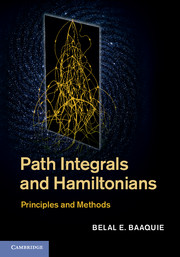Book contents
- Frontmatter
- Dedication
- Contents
- Preface
- Acknowledgements
- 1 Synopsis
- Part one Fundamental principles
- 2 The mathematical structure of quantum mechanics
- 3 Operators
- 4 The Feynman path integral
- 5 Hamiltonian mechanics
- 6 Path integral quantization
- Part two Stochastic processes
- Part three discrete degrees of freedom
- Part four Quadratic path integrals
- Part five Action with acceleration
- Part six Nonlinear path integrals
- References
- Index
4 - The Feynman path integral
from Part one - Fundamental principles
Published online by Cambridge University Press: 05 April 2014
- Frontmatter
- Dedication
- Contents
- Preface
- Acknowledgements
- 1 Synopsis
- Part one Fundamental principles
- 2 The mathematical structure of quantum mechanics
- 3 Operators
- 4 The Feynman path integral
- 5 Hamiltonian mechanics
- 6 Path integral quantization
- Part two Stochastic processes
- Part three discrete degrees of freedom
- Part four Quadratic path integrals
- Part five Action with acceleration
- Part six Nonlinear path integrals
- References
- Index
Summary
A path, in general, is defined by a determinate trajectory in time, from an initial to a final point. The classical trajectory is only one of the possible trajectories, and in quantum mechanics all the possible paths between the initial and final point come into play. Recall that the probability amplitude is a complex number that is assigned to each determinate path. Indeterminate paths are defined as a collection of determinate paths that are experimentally indistinguishable. In the Dirac–Feynman approach, the inherent indeterminacy of the quantum entity is realized by the degree of freedom – in undergoing time evolution – “taking” indeterminate paths [Baaquie (2013e)].
For a quantum degree of freedom evolving from an observed initial state to the observed final state – and with no other observations made – the Feynman path integral is a mathematical construction that computes the probability amplitudes by summing over all the allowed determinate paths of the degree of freedom – discussed in Feynman and Hibbs (1965), Zinn-Justin (1993), Zinn-Justin (2005) and Baaquie (2013e).
Probability amplitude and time evolution
Recall that the description of a quantum system, at a particular instant,isgiven by its state vector, namely |ψ>. To avoid confusion with the concept of a state vector, the term probability amplitude is used for describing a quantum entity undergoing transitions in time.
- Type
- Chapter
- Information
- Path Integrals and HamiltoniansPrinciples and Methods, pp. 61 - 79Publisher: Cambridge University PressPrint publication year: 2014



